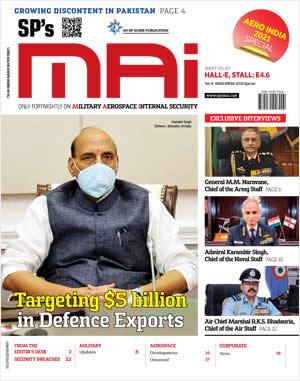INDIAN ARMED FORCES CHIEFS ON OUR RELENTLESS AND FOCUSED PUBLISHING EFFORTS

The insightful articles, inspiring narrations and analytical perspectives presented by the Editorial Team, establish an alluring connect with the reader. My compliments and best wishes to SP Guide Publications.

"Over the past 60 years, the growth of SP Guide Publications has mirrored the rising stature of Indian Navy. Its well-researched and informative magazines on Defence and Aerospace sector have served to shape an educated opinion of our military personnel, policy makers and the public alike. I wish SP's Publication team continued success, fair winds and following seas in all future endeavour!"

Since, its inception in 1964, SP Guide Publications has consistently demonstrated commitment to high-quality journalism in the aerospace and defence sectors, earning a well-deserved reputation as Asia's largest media house in this domain. I wish SP Guide Publications continued success in its pursuit of excellence.
- Prime Minister Modi Visits Punjab’s Adampur Air Base, Interacts with Airmen after Successful ‘Operation Sindoor’; Stern Message to Pakistan
- The layered Air Defence systems that worked superbly, the key element of Operation Sindoor
- Operation Sindoor | Day 2 DGMOs Briefing
- Operation Sindoor: India strikes back with Precision and Purpose
- Operation Sindoor: Resolute yet Restrained
- India’s Operation Sindoor Sends a Clear Message to Terror and the World – ‘ZERO TOLERANCE’
- Japan and India set forth a defence cooperation consultancy framework, talks on tank and jet engines
- Terrorist Attack in Pahalgam in Kashmir: Unfolding a long surgical war against PAK
- Lt General Pratik Sharma takes over Command of Indian Army's Northern Command
US–India inching closer
With major foundational agreements already in place and no major issues to be sorted out, the U.S. Defence Secretary visit focussed on broader aspects of India US strategic partnership and its role in ensuring peace and security in Indo-pacific region and ways and means to counter the aggressive designs of China
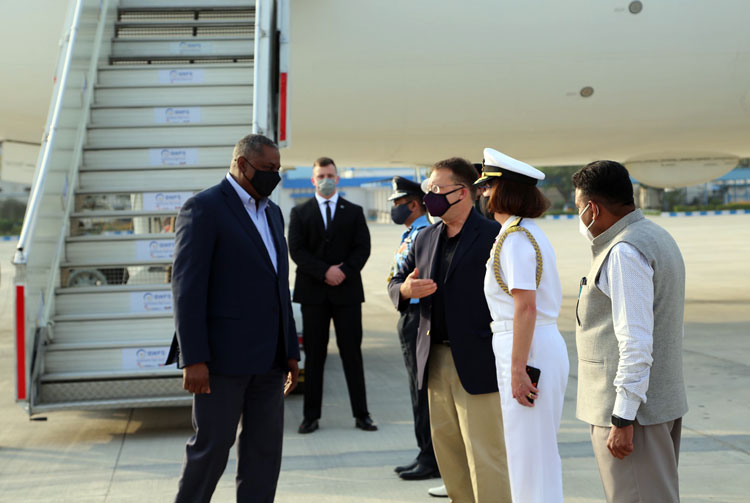
The March 19-20, visit of US Secretary of Defence Lloyd Austin to New Delhi has resulted in two countries inching more closer, in terms of functional cooperation between Indian armed forces and the United States Indo-pacific command, Central command and Africa command. This was significant takeaway from the Austin visit to India which paved the way for closer maritime cooperation in the high seas of Indian and Pacific oceans. With no particular issue high on the agenda, the visit of new US Defence Secretary was probably intended to get to know each other and to let the world know that India and US will further strengthen their bonds as close partner in the Indo-pacific region. On his part Secretary Austin revealed that he and Rajnath Singh discussed opportunities to elevate the US- India major defence partnership, which he described as priority of the Biden – Harris administration. He further said, “we will do that through regional security cooperation and military–to-military interaction and defence trade.”
Since this was the first highest level visit from the new leadership of US administration, there was much excitement in the strategic circles both in India and US and also concerns in India’s neighbourhood. The Austin visit cleared the roadmap for future cooperation, the foundation for which has already been laid in terms of conclusion of major foundational agreements, in the last days of Donald Trump administration. The visit was happening in the backdrop of almost a year long military standoff between India and China on the frozen mountainous borders of Eastern Ladakh and unprecedented material and intelligence support from the new US administration to India, which enhanced the fighting capabilities of Indian armed forces . Like the Trump administration, Joe Biden also declared unstinted moral and diplomatic support to India and held China guilty for the incursions on the borders which resulted in two armies coming face to face and almost on the verge of war.
Since this was the first highest level visit from the new leadership of US administration, there was much excitement in the strategic circles both in India and US and also concerns in India’s neighbourhood
Just a week after the first summit meeting of Quadrilateral grouping of India, US, Australia and Japan, the visit of US Defence Secretary, assumed more significance, in view of public spat between top diplomats of US and China, when they met in Alaska, just two days ago, on the issue of human rights . However, on his India visit , Mr Lloyd Austin avoided to make a public spectacle of issues like minority discrimination , human rights and Russian S-400 missile supplies to India, though he was instructed by the Chairman of the US Senate foreign relations committee to raise these issues with India. Pragmatism demanded that US should not pour cold water over the developing warmth between security establishments of the two countries in the backdrop of increasing aggressiveness of China , from South and East China seas to land borders with India. In fact Secretary Austin tried to sweep under the carpet, the issue of Russian S-400 missile deal to India, when he said that the missile has not yet been delivered to India, so there would be no reasons for sanctions. Probably, the US administration realises that, India would not be cancelling the S-400 deal at the cost of its deep rooted defence relationship with Russia.
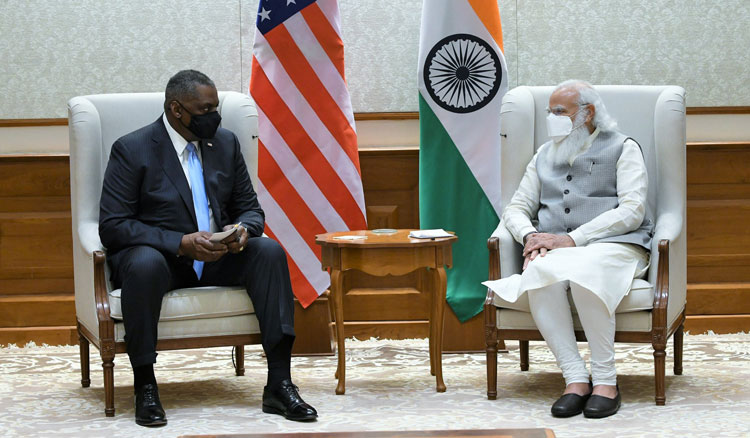
In spite of the discordant voices coming out from the US Senate, just on the eve of Austin’s visit to India, the new Defence Secretary ignored calls from the US Senate to warn India about the CAATSA ( Countering American Adversaries through Sanctions Act) provisions , which has a strong provision to sanction countries engaging in defence relations with Russia. No wonder , the Biden administration , within first 60 days of taking over , moved cautiously on India’s relations with Russia , signalled it is Secretary of Defence to ignore and only casually raise the issue of S-400 anti-missile deal between India and Russia , so as not to put a spanner in fast strengthening bilateral strategic partnership, which has assumed added significance in the backdrop of increasingly assertive and aggressive behaviour of China, with which the new Biden administration has decided to continue with the hard stance adopted during Donald Trump’s regime.
Just a week after the first summit meeting of Quadrilateral grouping of India, US, Australia and Japan, the visit of US Defence Secretary, assumed more significance, in view of public spat between top diplomats of US and China just two days ago
The Austin visit was thus intended to convey the message to their rival countries that US and Indian armed forces will together protect not only interests of each other but of the other Indo-pacific partners also. Hence, on his first international engagement, the new US Secretary of Defence Lloyd Austin, within two months of taking over , significantly chose India on his three nation tour. Among the three two were South Korea and Japan which are described as allies and India is now being considered as closer to an ally status , being a “major” defence partner, in newly evolving Indo-pacific construct . US considers India as linchpin of its Indo-pacific policy. Naturally , the first Secretary level visit from new US administration of Joe Biden, added fresh manure to let the Indo- US Defence and Strategic partnership flourish in a more mutually nourished friendly atmosphere , which started deepening and taking a new turn almost a decade and half ago. The relationship has been nurtured with added vigour during the successive US administrations which received much boost during the previous Donald Trump regime. The Biden administration decided to further deepen its partnership with India , which enjoys bi-partisan support in the US legislatures. From Republicans to Democrats, the US leaders have vouched to strengthen US –India strategic partnership , described as between the oldest and biggest democracies of the world . The relationship is based on democratic values and respect for plurality, as described by the Prime Minister Narendra Modi during his interaction with Secretary Austin , within hours of his landing in New Delhi on 19th March. The India US relationship has already been described as defining partnership of the 21st century by ex-President Barack Obama is underpinned by the mutual desire to deepen strategic cooperation in a fast changing geo-political equation. This feeling was echoed by Indian Defence Minister Rajnath Singh after his interaction with Secretary Austin next day, when he jointly addressed the media, during which he expressed his keenness to work together to realise full potential of the Indo-US comprehensive global strategic partnership for bringing peace and prosperity to both the countries.
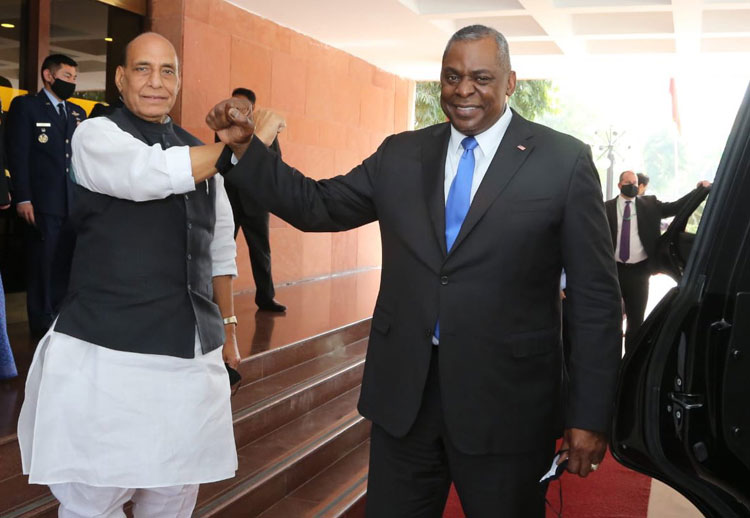
Defence Secretary Austin was accorded highest level interactions , from Prime Minister Modi to National Security Advisor Ajit Doval and working level meetings with Indian Defence Minister Rajnath Singh and External Affairs Minister Dr S. Jaishankar. During these high level confabulations, the visiting dignitary focussed on India’s critical role in Indo- pacific and US desire to take it to logical conclusion. During his meeting with Prime Minister Modi, Secretary Austin conveyed the strong desire of the Biden administration to “further enhance the strategic partnership for peace, stability and prosperity in the Indo-pacific region and beyond.”
In spite of the discordant voices coming out from the US Senate, the new Defence Secretary ignored calls from the US Senate to warn India about the CAATSA provisions , which has a strong provision to sanction countries engaging in defence relations with Russia
As US has emerged as major defence supplier to India over last one and half decade, during which equipment worth US$ 22 billion was transferred to Indian armed forces, India looks to more robust defence cooperation with US , as billions of dollars of defence hardware are already in pipeline for Indian forces. India now wants to move from buyer-seller relationship with United States to joint developer and producer of advanced weapon systems.
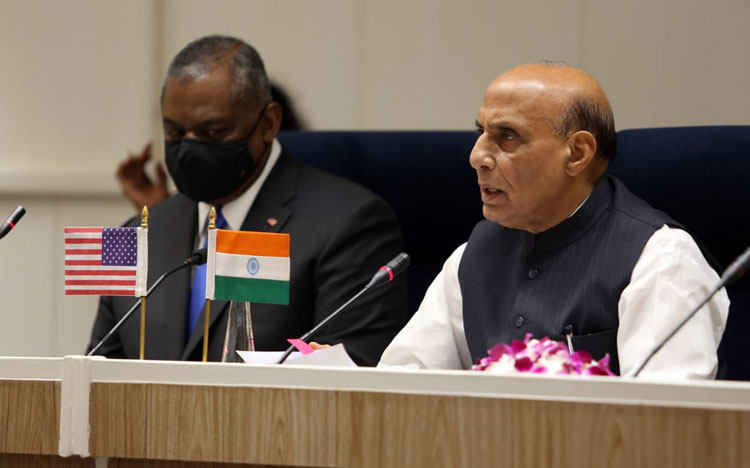
With major foundational agreements (LEMOA, COMCASA and BECA) already in place and no major issues to be sorted out, the Defence Secretary visit focussed on broader aspects of India-US strategic partnership and its role in ensuring peace and security in Indo-pacific region and ways and means to counter the aggressive designs of China. Just two days before Austin’s meetings in New Delhi, US Secretary of State Antony Blinken had rough encounters with Chinese State Councillor Yang Jie Chi and Foreign Minister Wang Yi in Alaska, indicating the trajectory of Sino- US relations. Since India is also a victim of Chinese aggressive designs on its 3488 kms long un-demarcated borders, the two democratic powers have found a common ground to evolve common strategies to tackle Chinese assertiveness and strategies to dominate the world.
The Austin visit was thus intended to convey the message to their rival countries that US and Indian armed forces will together protect not only interests of each other but of the other Indo-pacific partners als
Describing Secretary Austin’s first day meetings with Prime Minister Modi and National Security Advisor Doval, the US Embassy in New Delhi said, “Secretary Austin commended India’s leadership role in the Indo-pacific and growing engagement with like-minded partners across the region to promote shared goals . The two sides reaffirmed their commitment to promote free and open regional order. Both sides exchanged perspectives on shared challenges confronting the region and committed to further strengthen their broad ranging and robust defence cooperation.”
Defence Minister Rajnath Singh said that he looks forward to working with you (Austin) closely to make the Indo-US relationship one of the defining partnerships of 21st century
On March 20, the second day of his engagements, Secretary Ausitin had an extensive discussion with his Indian counterpart Rajnath Singh , after which Singh told media that his talks with Austin focussed on our wide ranging defence cooperation and expanding military to military engagement across services , information sharing, cooperation in emerging sectors of defence and mutual logistics support. Referring to March 12, Quadrilateral leaders summit virtually hosted by US , Rajnath Singh said that it emphasised our resolve to maintain a free , open and inclusive Indo-pacific region. We discussed the need for enhanced capacity building to address some of the non-traditional challenges. He declared that India is committed to further consolidate our robust defence partnership with United States. Singh further said that “he looks forward to working with you ( Austin) closely to make the Indo-US relationship one of the defining partnerships of 21st century. These sentiments were similarly echoed by Secretary Austin during media interaction, when he said that , “India is an increasingly important partner in today’s rapidly shifting international dynamics and I reaffirmed our commitment to a comprehensive and forward looking defence partnership with India as a central pillar of our approach to the region. US and India relationship is a stronghold of a free and open Indo-pacific region. Quoting Prime Minister Modi, Austin said that India stands for freedom of navigation and freedom of overflight, unimpeded , lawful commerce and inherence to international law.” Clearly Austin wanted to emphasize the significance of India and US jointly ensuring freedom of seas, challenged by China.
Without naming China, Austin said that Indo-pacific region faces acute transnational challenges, such as climate changes and challenges to a free and open regional border cooperation among like minded countries, is imperative to securing our shared vision for the future.” India and US have thus decided to chart a joint course of action to together tackle challenges to its allied partner’s strategic interests. The Austin visit would thus lead to more closer strategic cooperation in the Indo-pacific region.





